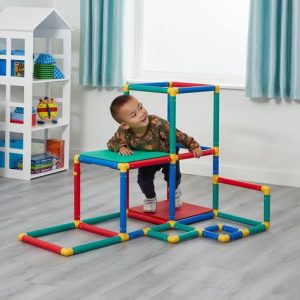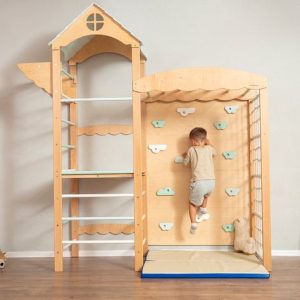Play gyms are popular baby products, but are they really worth the investment? This article explores the pros and cons of play gyms to help you decide if one is right for your little one.
What is a Play Gym?
A play gym is a soft, padded mat with overhead arches that hold colorful toys and dangly objects. Babies can lie on their backs, practice tummy time, sit up, and stand while playing with the toys. Some play gyms also have features like mirrors, crinkly fabrics, and musical components.
Benefits of Play Gyms
Play gyms can offer a variety of benefits for babies, including:
Supporting Development:
Play gyms can encourage babies to reach, grasp, and bat at toys, helping to develop their motor skills and hand-eye coordination.
Promoting Tummy Time:
Tummy time is essential for strengthening neck and back muscles. The play gym’s mat provides a comfortable and stimulating environment for babies to practice tummy time.
Sensory Stimulation:
The bright colors, different textures, and sounds of play gym toys can help stimulate babies’ senses and cognitive development.
Entertainment:
Play gyms can provide a safe and engaging space for babies to play and explore. This can be helpful for parents who need a short break or who want to encourage independent play.
Drawbacks of Play Gyms
While play gyms can be beneficial, there are also some drawbacks to consider:
-
Cost: Play gyms can range in price from affordable to expensive. Consider your budget and how often you think your baby will use it.
-
Space: Play gyms can take up a significant amount of floor space. If you have limited living space, a play gym might not be practical.
-
Outgrown Quickly: Babies grow and develop rapidly. Your baby might outgrow the play gym within a few months.
-
Not a Necessity: There are many other ways to encourage your baby’s development, such as providing them with safe toys and household items to explore.
Alternatives to Play Gyms
If you’re on the fence about getting a play gym, here are some alternatives:
-
A Play Mat: A simple play mat provides a safe and comfortable space for your baby to play. You can add your own toys and blankets for stimulation.
-
DIY Play Gym: If you’re crafty, you can create your own play gym using a blanket, some PVC pipes, and hanging toys.
-
Floor Time: Babies don’t need fancy equipment to develop. Regular floor time with supervision allows them to explore their surroundings and practice rolling, crawling, and reaching.
Making the Decision
Ultimately, the decision of whether or not to get a play gym is a personal one. Consider your baby’s needs, your budget, and your lifestyle. There is no right or wrong answer!
Here are some additional questions to ask yourself:
- Does my baby enjoy playing with toys that dangle or make sounds?
- How much space do I have in my home?
- Am I comfortable with the cost of a play gym?
By considering these factors, you can make an informed decision about whether or not a play gym is right for you and your baby.
Play gyms can be a valuable tool for supporting your baby’s development, but they are not essential. There are many other ways to encourage your baby’s growth and learning. The most important thing is to provide your baby with a safe and loving environment to explore and play.
Getting the Most Out of Your Play Gym
If you decide to get a play gym, here are some tips to get the most out of it:
-
Choose a developmentally appropriate play gym: Look for a play gym that offers features that match your baby’s age and stage of development. For example, younger babies might benefit from high-contrast colors and simple toys, while older babies might enjoy more complex toys and textures.
-
Rotate the toys: Babies can get bored with the same toys over time. Rotate the toys that are hanging on the gym to keep things fresh and interesting for your baby.
-
Use the play gym for tummy time: Tummy time is crucial for strengthening neck and back muscles. Place your baby on the play gym mat for supervised tummy time sessions.
-
Get down on the mat and play with your baby: Interaction is key for development. Spend time lying on the play gym mat with your baby, talking, singing, and playing with the toys together.
-
Keep it clean: Play gyms can be a breeding ground for germs. Wash the play gym mat regularly according to the manufacturer’s instructions.
Play Gyms and Screen Time
Play gyms are a great way to encourage active play and development. The American Academy of Pediatrics (AAP) recommends limiting screen time for babies under 18 months. Avoid using the play gym as a way to prop up your baby in front of a screen.
Play gyms can be a valuable tool for supporting your baby’s development, but they are not essential. There are many other ways to encourage your baby’s growth and learning. The most important thing is to provide your baby with a safe and loving environment to explore and play.
By considering the pros and cons, exploring alternatives, and following the tips above, you can make an informed decision about whether or not a play gym is right for you and your baby.

Making the Decision: Play Gym or Not?
Here’s a quick decision tree to help you decide if a play gym is right for you:
- Do you have the space for a play gym?
- Does your budget allow for a play gym?
- Does your baby seem interested in hanging toys and dangly objects?
If you answered yes to most of these questions, a play gym might be a good fit. If you’re not sure, there are plenty of other ways to stimulate your baby’s development.
The Bottom Line
Play gyms can be a fun and stimulating addition to your baby’s playtime. But remember, they aren’t essential. The most important thing is to provide your baby with a safe and loving environment to explore and play.
Here are some key takeaways:
- Play gyms can support development, promote tummy time, and provide entertainment.
- Consider cost, space, and outgrowing the play gym before buying.
- Play mats and DIY options offer alternatives to traditional play gyms.
- The most important thing is providing a safe and loving environment for play.
By considering your baby’s needs and your lifestyle, you can make an informed decision about whether or not a play gym is the right choice for you.




